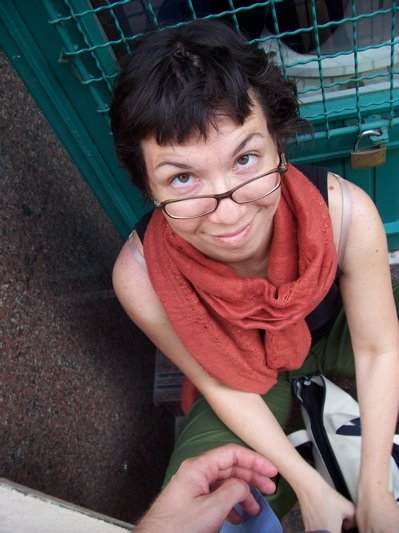
Post Prelude:
I love carnival. I love the idea of a time when all life’s normal rules are suspended: a vacation from order, from responsibility, from accountability, from moderation.
We spent this carnival in Mohács, Hungary, home of the Busojárás carnival. Busojárás originally came here with the Slavic Sokacs people, and has roots in ancient Slavic paganism. But unlike other Slavic carnivals, Busojárás does not feature animal masks. Here and only here the masks (“busos”) are humans with horns, wooly hair all over, and no self-control.
The Buso Checklist:

Mask. Of course the mask. Unlike other carnival masks, these are never mass-produced—each wooden Buso mask is different.

Our friend Tamasz's grandfather made these masks, which his crew Boros Kolo still uses. (Their group’s name is a pun on fave Hungarian drink “wine and cola,” using the word “kolo,” the official dance of carnival). This is him before “suiting up” for carnival, with the very first mask his grandfather made for him.

Many Mohács men still make their own masks. Although even many natives don’t realize it, every part of the mask—from the horns to the color to the shape of the eyes—is symbolic…but more about that later. Ideally, a Buso never takes off his mask.
Wine. Check. Our Boros Kolo friends told us that the government actually gives them free wine for the duration of carnival.

Cowbells and noisemakers. Used to a) announce the busos’ approach, b) ward off the evil spirits of winter and death, and c) raise the roof. The wooden Buso-Horn—for those who can actually sound it—sounds like a plastic football rally trumpet.

Women’s stockings under traditional Sokacs mens’ underwear. This local in-joke harkens back to the time when almost no one went masked. Centuries ago, before carnival was a tourist attraction, most Sokacs revelers crossdressed: the men dressed up as women and vice versa.

These womens’ stockings are a reminder of that tradition, which still survives among a few serious Mohács partiers.

Hay-stuffed trousers. Theoretically a buso should be totally anonymous, free to do whatever (and whoever) without fear of recognition. Stuffing hay down your pants keeps your wife from Where’s-Waldoing your legs.

Chilis and paprikas and other plant life. old pagan decorations, reminders of the return of life in the spring.

Pitchforks, paddles, cannons, maces and donuts. There’s an added layer to carnival in Mohács: remembrance of the Hungarian defeat at the Battle of Mohács (1526). This defeat opened the door to the Turkish invasion of Buda and Turkish domination of Central Hungary. Memories are long and bitter here; the battle is an essential part of the town’s identity. There’s a “pretty legend” that Busos scared the Turkish occupiers away from Mohács. One dark and stormy night (the story goes), local people hiding in the wilderness of Mohács Island donned terrifying masks, crossed the river in boats, and frightened the Turks away. To commemorate this victory, the Busos paddle across the Danube from Mohács Island every Carnival Sunday.


The donuts on the Busos’ horns are symbolic Turkish heads. Mmmm...symbolism...

The funny thing is that Mohács wasn’t settled until after the Turks were long gone. Many Mohács residents confessed to us that the legend probably wasn’t true. One drunk Buso told us the “real” Buso connection with Mohács Island: once upon a time—before anyone lived on the island, before dad’s car—young couples used to go there to get it on.
Still, the story of the Terrified Turks lives on. The Busos carry weapons to drive away the Turks—and by extension, winter, death and oppression.

The idea of Busos socking it to The Man survives in other ways, too. Here’s a poster of a buso beating up Hungarian PM Gyurcsany:

Staffs. Many people told us that these are just for decoration, but some staffs hint at a more universal symbolism (modest readers avert your eyes):


Water-Carrier. This is a yoke with hooks to hang water buckets from. In the old days, when the Busos used to go door to door bringing good luck to houses, they carried this with them. If a buso entered a house and handed the water-carrier to a young lady, it meant one of his masked brothers wanted to marry her.

Baby buso. When a buso carries a buso doll, it means he has a baby boy and is asking for the community’s blessing. It can also mean that the buso is married and hoping for a child. Our friend Árpád just became the proud father of his first child, a baby boy, three weeks ago:


1 comment:
I just became the proud owner of a Busos mask, carved by Antal in 1995-6. I don't think it was ever used in the festival; it appears to be unused. It is beautifully ugly, and amusingly threatening. I'm a collector of folk/tribal masks; and would love to find other European masks. jbeazell@gmail.com
Post a Comment